Content
Published:
Updated:
This is an archived release.
The numbers of prosecutions conditionally dropped in 2013-2015 were changed 1 June 2018. The changes mean that some of the figures in this article are not entirely in line with the latest official statistics in StatBank and the article that describes developments until 2015.
More persons sanctioned for drug crimes
In total, 309 400 sanctions were registered in 2013. Compared to the year before, there was a 3.9 per cent drop in misdemeanour cases, while crime cases increased by 10.8 per cent. A total of 29 600 persons were sanctioned for crimes, of which more than 13 800 had a drug crime as the principal offence.
| 2013 | |
|---|---|
| All types of sanctions | 309 376 |
| All types of sanctions, on the spot fine not included | 80 553 |
| Sanctioned persons | 274 261 |
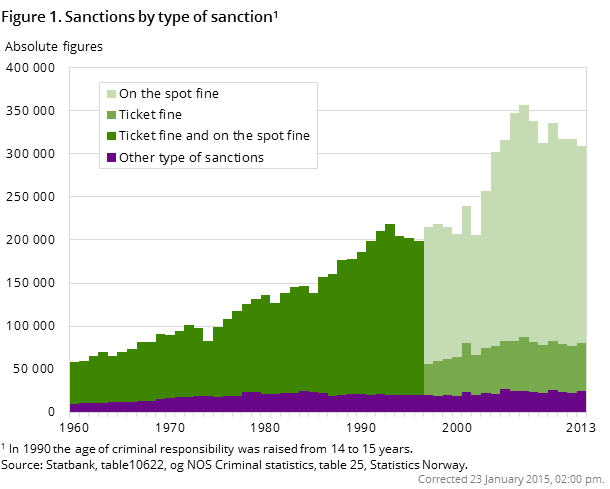
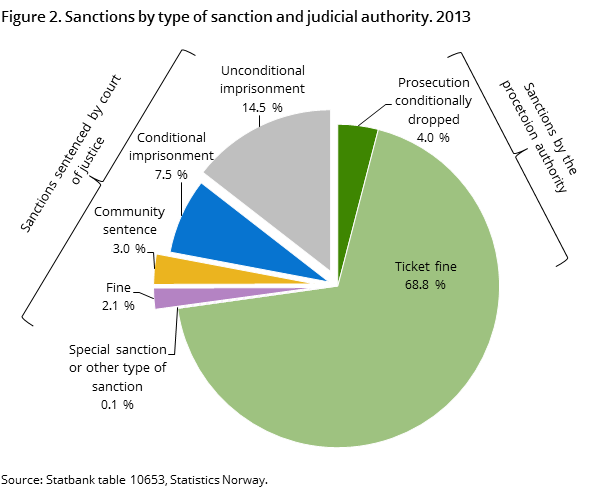
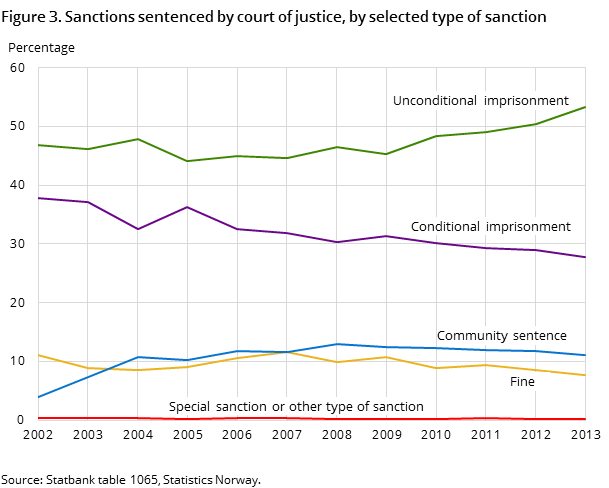
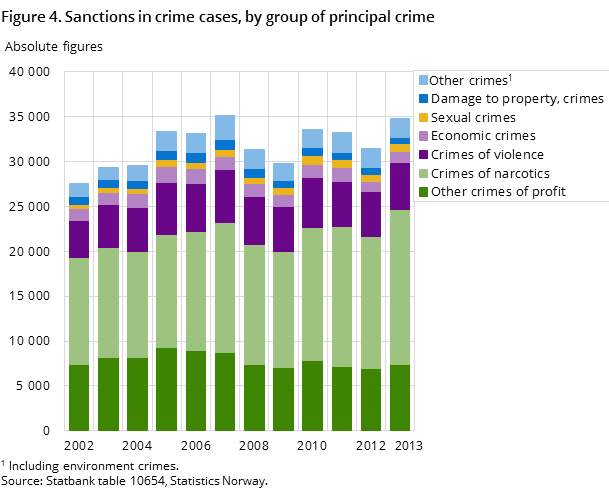
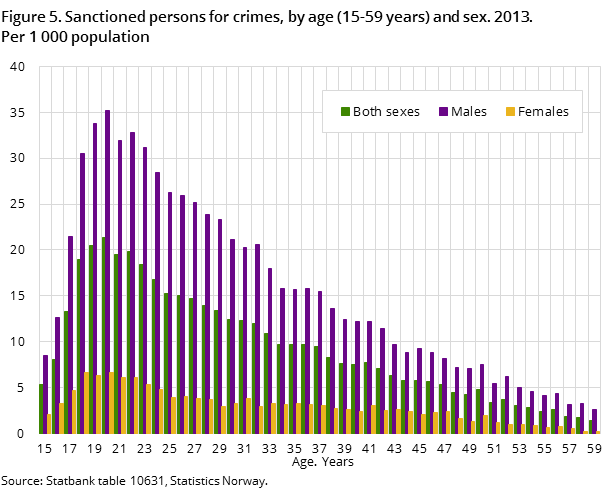
In 2013, a total of 309 400 sanctions were registered, 274 500 of which were issued for misdemeanours only and over 34 800 given in crime cases. Compared to the year before, this is 11 000 fewer and 3 400 more sanctions respectively.
Compared to 2012, cases with traffic and drug crimes as the principal offence saw the biggest changes, with a 4 per cent drop and as much as a 17 per cent increase respectively. In total, there were somewhat fewer sanctions for offences for profit, however, the more serious crimes in this group of offence saw a 6 per cent increase from the year before. The number of registered sanctions for violent and sexual crimes also saw a slight increase from 2012.
Fewer on the spot fines for traffic or Customs Act misdemeanours
A total number of 228 800 on the spot fines were issued in 2013. The police and the customs service have authority to issue on the spot fines for less serious traffic misdemeanours and misdemeanours against the Customs Act. This type of sanction made up 74 per cent of all sanctions registered in 2013. More than nine out of ten on the spot fines were issued as a result of misdemeanours against the Road Traffic Act, for the most part for illegal speed. In summary, 2013 saw 9 900 fewer on the spot fines for misdemeanours against the Road Traffic Act and 1 500 fewer misdemeanours against the Customs Act, compared to 2012. This contributed to a drop of 7 600 – or 2.4 per cent in the total number of registered sanctions from 2012 to 2013.
Increase in crime cases, mostly due to drug crimes
In 2013, the total number of 34 800 sanctions in crime cases were 3 400 – or 11 per cent – more than the year before. The increase in cases with narcotic crimes as the principal offence amounts to as much as three quarters of the total crime increase – as illustrated in figure 4. The 2013 increase in narcotic crimes is also shown in the statistics on Offences reported to the police and Offences investigated.
Drug crime is the principal offence in half of all crime cases
In 2013, a total of 17 300 sanctions were given for narcotic offences as the principal offence, which is 2 550 more than the year before. In numbers, the increase was about the same for less serious drug crimes against the Act relating to medicinal products as for drug violations against the Penal Code.
The number of sanctions with drug crimes as the principal offence made up nearly 50 per cent of all registered sanctions for crimes in 2013; by far the biggest share ever registered. In 2013, the number of sanctions is also clearly higher than all previous years. However, taking the population growth into consideration, the frequency of sanctions for drug crimes is level with 2001.
More prison sentences given by the courts
The 21 900 sanctions given by the court in 2013 are 2 100 more than the year before. The increase was most significant for unconditional imprisonThe corresponding share for women is 3 per cenment. The total of 11 700 sanctions with unconditional imprisonment was 1 700 – or as much as 17 per cent – more than in 2012. The number of sentences with conditional imprisonment also saw a slight increase, where the 6 100 sentences given made up 350 – or 6 per cent – more than the year before.
In 2013, unconditional imprisonment made up 53 per cent of all sanctions given by the courts. As illustrated in figure 3, this form of sanction has been increasingly used by the courts since the middle of the 2000s.
Most sanctions by the Prosecution Authority; most sentences by city and districts courts
Despite the increase in sanctions given by the court, and the decrease in sanctions issued by the Prosecution Authority, most criminal cases are still settled without courtroom prosecution. In 2013, as much as 92.9 per cent of all sanctions were issued by the Prosecution Authority. Excluding on the spot fines issued in traffic or Customs Act cases, the majority of the remaining sanctions – nearly three out of four – are still issued by the Prosecution Authority, as shown in figure 2.
Out of all sanctions given by the courts in 2013, 94 per cent were given in the city and district courts. The more than 20 600 cases settled in the city and district courts was 2 050 more than the year before. The remaining criminal cases were appealed to higher judicial authorities, of which 1 250 cases were settled by the lower appeal courts and 41 cases by the Supreme Court.
Unconditional imprisonment and preventive detention given by lower appeal courts
In the city and district courts, 52 per cent of all prosecuted criminal cases were settled by unconditional imprisonment, while 29 per cent were sanctioned by conditional imprisonment. The corresponding shares in the lower appeal courts were 75 and 13 per cent respectively. Of the total 140 preventive detentions given during the last decade, nearly six out of ten were given in the lower appeal courts. Furthermore, of the 165 compulsory mental care sentences given during the same period, nine out of ten were given by the lower appeal courts.
One out of ten given more than one sanction
In 2013, 10.5 per cent of all persons sanctioned were given more than one sanction. Men and adolescents are overrepresented among those given multiple sanctions. Of all sanctioned men, 12 per cent were given two or more sanctions in 2013, while the corresponding figure for women was less than 7 per cent.
Three out of four sanctioned are men
Out of all cases with registered information on the sanctioned person’s sex, 76 per cent were men. Of the resident male population aged 15 years and over, as much as 9.2 per cent were given one or more sanction during the year. The corresponding share for women is 3,0 per cent. Most persons sanctioned have committed less serious offences, and this is especially the case for sanctioned women. For those registered as Norwegian residents, sanctions for crimes were given to nearly 1.1 per cent of men and only 0.2 per cent of women. As in previous years, women make up the largest shares among persons sanctioned for traffic misdemeanours (26 per cent), offences for profit (25 per cent) and narcotic offences (15 per cent).
Sanctions for crime most often given to young adults
Youths are significantly overrepresented among those sanctioned for crimes, and as illustrated by figure 5, this overrepresentation applies to both sexes. Men in the age group 18-23 years were more sanctioned than other men, with more than 3 per cent of this population being sanctioned during the year. Out of all men sanctioned in crime cases; 51 per cent were between 17 and 29 years of age.
More – and most – persons sanctioned for crimes in Oslo
The number of persons sanctioned for crimes residing in Oslo and Sør-Trøndelag increased by 26 per cent from 2012 to 2013. Thus, Oslo is now the county with the highest share of persons sanctioned for crimes, with 8.3 per 1 000 population. The corresponding shares in Nord-Trøndelag and Sogn og Fjordane, the counties with the lowest shares, are 4.3 and nearly 4.4 per 1 000 population respectively.
Most sanctioned persons are Norwegian residents
Out of all persons sanctioned in 2013, 95.5 per cent were registered residents in Norway. Thus, almost 6.2 per cent of the population aged 15 years and over was sanctioned for one offence or more during 2013. The corresponding figure for persons sanctioned for crimes was 0.6 per cent.
About 8 out of 10 are Norwegian citizens
In 2013, 76 per cent of persons sanctioned for crimes held a Norwegian citizenship. The corresponding share for misdemeanours was slightly over 83 per cent. The share of persons sanctioned who hold a Norwegian citizenship varies significantly between the different groups of offences. By far the lowest share was registered among persons sanctioned for offences for profit, where 54 per cent held a Norwegian citizenship. Furthermore, the share of Norwegian citizens among persons sanctioned for narcotic and traffic offences was 80 and almost 87 per cent respectively.
More years with more content available in StatbankOpen and readClose
Figures for sanctions in the time period 2002-2010 and for persons sanctioned from 2005-2010 are now available in StatBank. Furthermore, the statistics for these periods are expanded with more, and more detailed, tables on type of sanction, type of offence, age, sex, type of judicial authority and whether or not sanctioned persons have a criminal record. Figures on sanctions and persons sanctioned by citizenship, however, are not published in StatBank, but historical figures are available in Archive for Sanctions. Twenty permanent tables containing selected figures for the last published year have also been added to the main site for these statistics.
Certain adjustments and corrections in new StatBank statisticsOpen and readClose
Compared to previously published statistics, some concepts and definitions have been adjusted for certain categories, e.g. type of sanction and conditional imprisonment. Quality improvements have also been made to the information in some cases in the data basis for previous years. Among other things, this revision has led to a correction of figures for crimes and misdemeanours in 2002 and a regrouping of the number of sanctions by type of judicial authority for the year 2002-2007. From 2000 and onwards, figures in StatBank are at all times considered official statistics on sanctions. For more information on definitions and previous corrections, see About the statistics.
Contact
-
Sigmund Book Mohn
E-mail: sigmund.mohn@ssb.no
tel.: (+47) 94 32 77 22
-
Reid Jone Stene
E-mail: reid.jone.stene@ssb.no
tel.: (+47) 99 02 22 01
